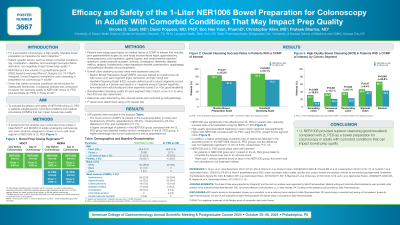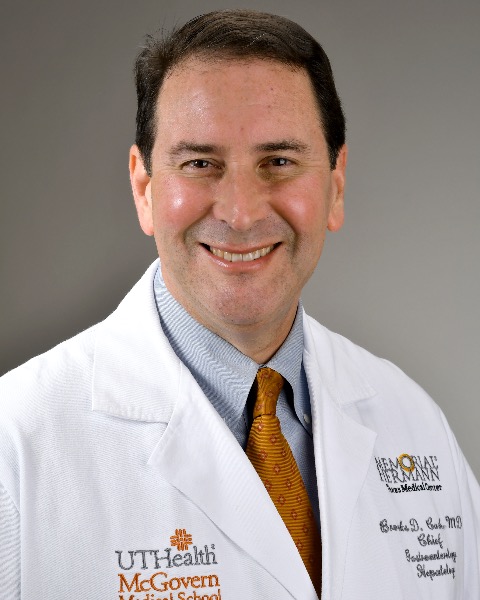Tuesday Poster Session
Category: Colon
P3667 - Efficacy and Safety of the 1 Liter NER1006 Bowel Preparation for Colonoscopy in Adults With Comorbid Conditions That May Impact Prep Quality
Tuesday, October 29, 2024
10:30 AM - 4:00 PM ET
Location: Exhibit Hall E

Has Audio

Brooks D. Cash, MD, FACG
The University of Texas Health Science Center at Houston
Houston, TX
Presenting Author(s)
Award: Presidential Poster Award
Brooks D. Cash, MD, FACG1, David Poppers, MD, PhD2, Soo Han Yoon, PharmD3, Christopher Allen, MS3, Prateek Sharma, MD4
1The University of Texas Health Science Center at Houston, Houston, TX; 2NYU Langone Health, New York, NY; 3Salix Pharmaceuticals, Bridgewater, NJ; 4University of Kansas School of Medicine and VAMC, Kansas City, KS
Introduction: For a successful colonoscopy, high-quality tolerable bowel prep is imperative for lesion detection. Patient-specific factors, such as certain comorbid conditions (eg, diabetes, constipation, neurologic/neuropsychiatric disorders), can negatively impact prep quality. Our aim was to evaluate the efficacy/safety of the 1L bowel prep NER1006 vs a 2L polyethylene glycol plus ascorbate solution (2L PEG) in patients stratified by comorbid conditions/medical procedures (CCMP) that can impact prep quality.
Methods: A pooled post hoc analysis was conducted of 2 phase 3 trials (NOCT/MORA) of adults undergoing colonoscopy randomized to PM/AM split-dose regimens of NER1006 (NOCT/MORA) or 2L PEG (MORA). Patients with a medical history of CCMP of interest were included. Overall colon cleansing success rates were assessed using the Boston Bowel Preparation Scale (BBPS; success defined as overall score ≥ 6 with score ≥ 2 in each segment [right, transverse, and left colon]) and Harefield Cleansing Scale (HCS; success defined as all 5 colonic segments scored 3 [clear liquid] or 4 [empty and clean] or ≥ 1 segment scored 2 [brown liquid/fully removable semi-solid stools] and other segments scored 3 or 4 [ie, good/excellent]). Good/excellent cleansing quality for each segment (free of stool; score 3 or 4) using the HCS was also determined.
Results: 248 patients were included (NER1006 [n = 189] vs 2L PEG [n = 59]): the majority were female (66.7% vs 69.5%) and the mean age was 58.9 y vs 56.6 y (overall range, 22-86 y). The most common CCMP of interest were hysterectomy (33.9%), appendectomy (30.6%), cholecystectomy (23.4%), diabetes (21.4%), and constipation (15.7%). NER1006 was significantly more effective than 2L PEG in overall colon cleansing success rates using BBPS (83.1% vs 67.8%, respectively; P = 0.01) and HCS (87.3% vs 71.2%; P = 0.004). Good/excellent cleansing quality in each colonic segment was significantly higher with NER1006 vs 2L PEG using HCS, except for the sigmoid colon: ascending (30.7% vs 11.9%; P = 0.004); transverse (35.4% vs 20.3%; P = 0.03); descending (38.1% vs 22.0%; P = 0.02); sigmoid (46.0% vs 40.7%; P = 0.47); and rectum (66.1% vs 42.4%; P = 0.001). Both preps were well tolerated. No patients in NER1006 and 1 patient in the 2L PEG group failed to complete the bowel prep due to an AE.
Discussion: 1L NER1006 provided superior cleansing (good/excellent) vs 2L PEG as a bowel prep for colonoscopy in adults with comorbid conditions that can impact bowel prep quality.
Disclosures:
Brooks D. Cash, MD, FACG1, David Poppers, MD, PhD2, Soo Han Yoon, PharmD3, Christopher Allen, MS3, Prateek Sharma, MD4. P3667 - Efficacy and Safety of the 1 Liter NER1006 Bowel Preparation for Colonoscopy in Adults With Comorbid Conditions That May Impact Prep Quality, ACG 2024 Annual Scientific Meeting Abstracts. Philadelphia, PA: American College of Gastroenterology.
Brooks D. Cash, MD, FACG1, David Poppers, MD, PhD2, Soo Han Yoon, PharmD3, Christopher Allen, MS3, Prateek Sharma, MD4
1The University of Texas Health Science Center at Houston, Houston, TX; 2NYU Langone Health, New York, NY; 3Salix Pharmaceuticals, Bridgewater, NJ; 4University of Kansas School of Medicine and VAMC, Kansas City, KS
Introduction: For a successful colonoscopy, high-quality tolerable bowel prep is imperative for lesion detection. Patient-specific factors, such as certain comorbid conditions (eg, diabetes, constipation, neurologic/neuropsychiatric disorders), can negatively impact prep quality. Our aim was to evaluate the efficacy/safety of the 1L bowel prep NER1006 vs a 2L polyethylene glycol plus ascorbate solution (2L PEG) in patients stratified by comorbid conditions/medical procedures (CCMP) that can impact prep quality.
Methods: A pooled post hoc analysis was conducted of 2 phase 3 trials (NOCT/MORA) of adults undergoing colonoscopy randomized to PM/AM split-dose regimens of NER1006 (NOCT/MORA) or 2L PEG (MORA). Patients with a medical history of CCMP of interest were included. Overall colon cleansing success rates were assessed using the Boston Bowel Preparation Scale (BBPS; success defined as overall score ≥ 6 with score ≥ 2 in each segment [right, transverse, and left colon]) and Harefield Cleansing Scale (HCS; success defined as all 5 colonic segments scored 3 [clear liquid] or 4 [empty and clean] or ≥ 1 segment scored 2 [brown liquid/fully removable semi-solid stools] and other segments scored 3 or 4 [ie, good/excellent]). Good/excellent cleansing quality for each segment (free of stool; score 3 or 4) using the HCS was also determined.
Results: 248 patients were included (NER1006 [n = 189] vs 2L PEG [n = 59]): the majority were female (66.7% vs 69.5%) and the mean age was 58.9 y vs 56.6 y (overall range, 22-86 y). The most common CCMP of interest were hysterectomy (33.9%), appendectomy (30.6%), cholecystectomy (23.4%), diabetes (21.4%), and constipation (15.7%). NER1006 was significantly more effective than 2L PEG in overall colon cleansing success rates using BBPS (83.1% vs 67.8%, respectively; P = 0.01) and HCS (87.3% vs 71.2%; P = 0.004). Good/excellent cleansing quality in each colonic segment was significantly higher with NER1006 vs 2L PEG using HCS, except for the sigmoid colon: ascending (30.7% vs 11.9%; P = 0.004); transverse (35.4% vs 20.3%; P = 0.03); descending (38.1% vs 22.0%; P = 0.02); sigmoid (46.0% vs 40.7%; P = 0.47); and rectum (66.1% vs 42.4%; P = 0.001). Both preps were well tolerated. No patients in NER1006 and 1 patient in the 2L PEG group failed to complete the bowel prep due to an AE.
Discussion: 1L NER1006 provided superior cleansing (good/excellent) vs 2L PEG as a bowel prep for colonoscopy in adults with comorbid conditions that can impact bowel prep quality.
Disclosures:
Brooks Cash: AbbVie – Consultant, Speaker. Alnylam Pharmaceuticals – Speaker. Ardelyx – Consultant, Speaker. AstraZeneca – Consultant, Speaker. Phathom Pharmaceuticals – Consultant, Speaker. QOL Medical LLC – Speaker. Regeneron Pharmaceuticals – Speaker. Salix Pharmaceuticals – Consultant, Speaker. Sanofi – Speaker.
David Poppers: Salix Pharmaceuticals – Consultant, Speakers Bureau.
Soo Han Yoon: Salix Pharmaceuticals – Employee.
Christopher Allen: Salix Pharmaceuticals or its affiliates – Employee.
Prateek Sharma: Salix Pharmaceuticals – Consultant.
Brooks D. Cash, MD, FACG1, David Poppers, MD, PhD2, Soo Han Yoon, PharmD3, Christopher Allen, MS3, Prateek Sharma, MD4. P3667 - Efficacy and Safety of the 1 Liter NER1006 Bowel Preparation for Colonoscopy in Adults With Comorbid Conditions That May Impact Prep Quality, ACG 2024 Annual Scientific Meeting Abstracts. Philadelphia, PA: American College of Gastroenterology.

